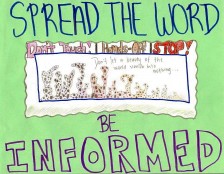Rudy Bonn, Reef Relief Director of Marine Projects
There is only one ocean, divided into different basins: the Pacific, Atlantic, Indian, Arctic, and the Southern basin that surrounds the continent of Antarctica. The reason why we use the one ocean concept at Reef Relief is because it has been proven that all that water is connected, constantly intermixing in all of the basins for billions of years. For example, if you were to travel to the North Atlantic basin and take a water sample and then travel south to the Southern basin and take a water sample both samples would contain identical minerals, gases, and so forth in the exact same proportions. This is called “The Law of Constant Proportions,” and it tells us that the waters of the world ocean have been intermixing since they first appeared billions of years ago. It all started as the Earth’s crust began to cool which allowed liquid water to begin to pool on its surface. Tectonics, or plate movement, formed the ocean basins and the positions of the continents that we now know—that process is still continuing today.
The world ocean contains 97% of the available living space on planet Earth; the Pacific basin alone covers 1/3 of the Earth. The Pacific basin is also the deepest. In the Marianas Trench south of Guam, the Pacific basin falls nearly 7 miles in a place known as the Challenger Deep. The world ocean supplies us with millions of metric tons of seafood every year and 50 to 80% of the oxygen we breathe through photosynthesis. This process is conducted by phytoplankton, microscopic plants that live in the surface waters of the world ocean and could very well be the most important organisms on Earth. If we were to lose the ocean via pollution, climate change, and other factors we would cease to exist!
Is this important information about our world ocean that we should teach in our schools? I, along with many others, certainly think so!
Reef Relief and many of our partners, such as the Sigsbee Charter School, the Montessori School, Key West High School, Florida Keys Community College, NOAA, and many others conduct, support, and encourage marine education. We understand the importance of educating the younger generations that will have to face and attempt to solve the many challenges that we are now encountering with regards to the health and sustainability of the Earth and Ocean.
Sigsbee Charter School’s curriculum is based on marine education and has been highly successful at teaching young students the importance of our ocean, our coast, and other natural ecosystems. The teachers and administrators at Sigsbee have been nationally recognized for their efforts and their work regarding marine education and Reef Relief is honored to be able to work with Sigsbee regarding the education of young minds in the marine sciences.
Are we doomsayers? Should we paint a picture of the consequences that may occur in the future if we fail to recognize the harm that some of our own actions are responsible for involving the degradation of Earth’s natural resources?
The answer is NO! Do we shy away from the truth? The answer is NO!
We teach young minds the importance of natural systems. We teach young minds about the challenges that we are all facing at the present time. We teach young minds what they can do to help stop the impact of our own actions on the natural world. We ask young minds many questions and their responses are always positive and they want to know what they can do to help protect and restore our own coral reef. Reef Relief’s Coral Camp for Kids teaches six through 12 year olds the importance of having a clean and healthy Earth and Ocean.
We marine educators want to instill in these young minds an environmental ethic; we want to make available the tools that they can use to be successful at whatever path they may choose in life; we also want to help them with their self-esteem, self-confidence, self-respect, and respect for others. It’s not always marine education, but through our efforts at education, our students learn how to socialize with their peers, how to have fun while learning, and how to develop a caring attitude about the Earth and the Ocean and the courage to make their voices heard when the time comes.
The kids today are so much brighter and they want to learn, they want to help, they want to keep the Earth and Ocean healthy and sustainable, they want to enjoy nature’s artwork, and they want to continue painting it. It is essential that we, as educators, ensure that the opportunities are always there for giving kids a chance to know, love, and respect the Earth and the Ocean and to give them a chance at changing actions, attitudes, and behaviors that harm our Earth and our Ocean. It is our responsibility and it is a requirement, as far as I am concerned, to help young minds fulfill their dreams by existing in a place where those aspirations can be achieved. Through our commitment to education, our children will continue to be inspired by a beautiful and healthy Earth and Ocean.
